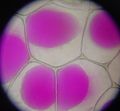Lysis facts for kids
Lysis is a scientific word that means a cell's outer layer, like its wall or membrane, breaks apart. When this happens, the cell can no longer work and it dies. This process often occurs when a cell is attacked by tiny invaders like a virus or special chemicals called enzymes. It's like a tiny balloon popping when it's poked or filled with too much water.
Contents
What is Lysis?
Every living thing, from a tiny bacterium to a giant tree, is made of cells. Cells are the basic building blocks of life. Each cell has a protective outer layer. In animal cells, this is called the cell membrane. Plant cells and bacteria also have a cell wall outside their membrane, which gives them extra strength. Lysis is what happens when these protective layers are damaged and the cell bursts open.
How Cells Break Down
Lysis can happen in different ways. Sometimes, it's caused by something attacking the cell from the outside. Other times, it's due to an imbalance inside or around the cell. Understanding these different causes helps scientists learn more about how cells work and how to fight diseases.
Lysis Caused by Viruses
One common way cells undergo lysis is when they are infected by a virus. Viruses are very tiny particles that cannot live or reproduce on their own. They need to enter a living cell to make copies of themselves. Once inside, a virus takes over the cell's machinery. It forces the cell to make many new virus particles. When there are too many new viruses inside, the cell can become so full that it bursts open. This releases all the new viruses, which then go on to infect other cells. This is how many viral infections spread in the body.
Lysis from Enzymes
Enzymes are special proteins that speed up chemical reactions. Some enzymes can break down the parts of a cell. For example, certain bacteria produce enzymes that can break down the cell walls of other bacteria. This is a way they compete for resources. Our own bodies also use enzymes to cause lysis. For instance, some of our immune cells release enzymes to destroy infected or harmful cells. This is an important part of how our body fights off sickness.
Water and Cell Lysis
Cells need a balanced environment to survive. Water can move in and out of cells through their membrane. This movement is called osmosis. If a cell is placed in water that is much purer than the water inside the cell, too much water will rush into the cell. This makes the cell swell up. Animal cells, which only have a cell membrane, can swell so much that they burst. This is called cytolysis. Plant cells have a strong cell wall, so they usually don't burst. Instead, they become very firm, which is called turgor pressure. However, if a plant cell loses too much water, its membrane can pull away from the cell wall, which is called plasmolysis. This can also damage the cell.
Why Lysis Matters
Lysis is a very important process in biology. It's not always a bad thing. For example, our immune system uses lysis to destroy harmful bacteria and virus-infected cells. Scientists also use lysis in laboratories. They can intentionally cause cells to lyse to study what's inside them. This helps them understand how cells work, discover new medicines, and even create new technologies.
Images for kids
See also
 In Spanish: Lisis para niños
In Spanish: Lisis para niños


